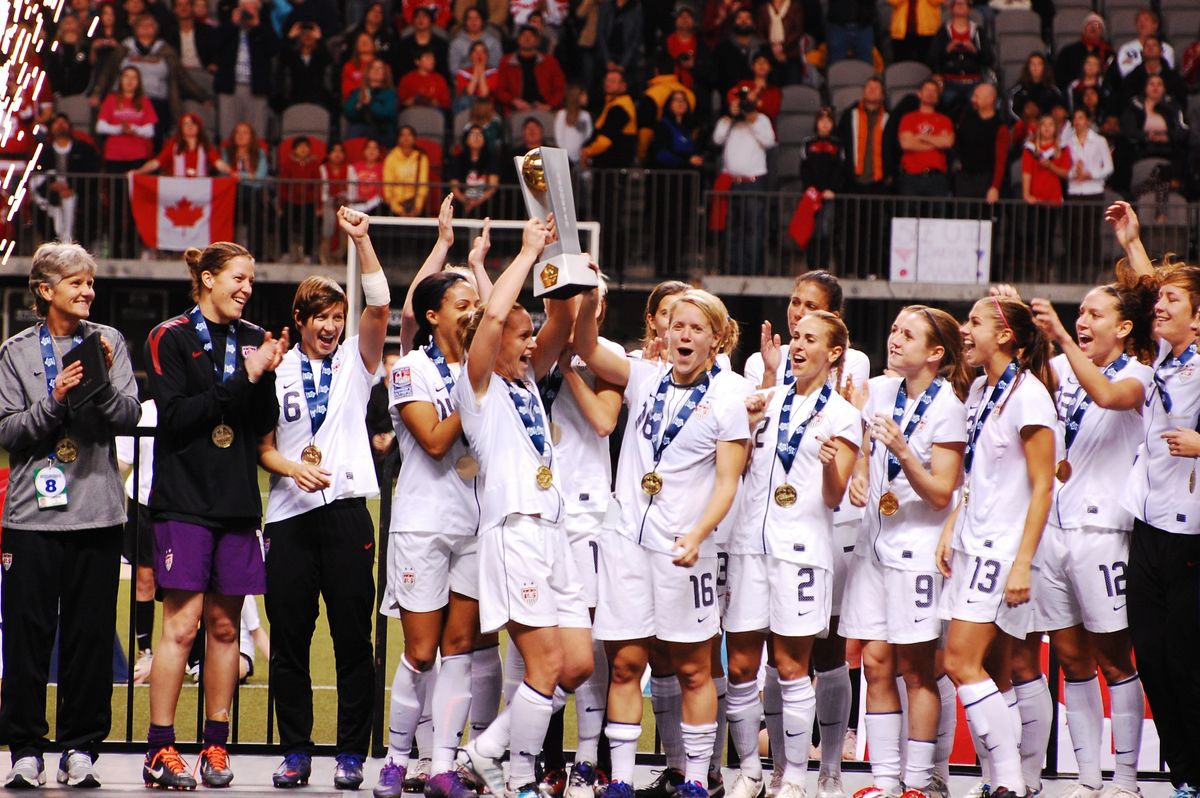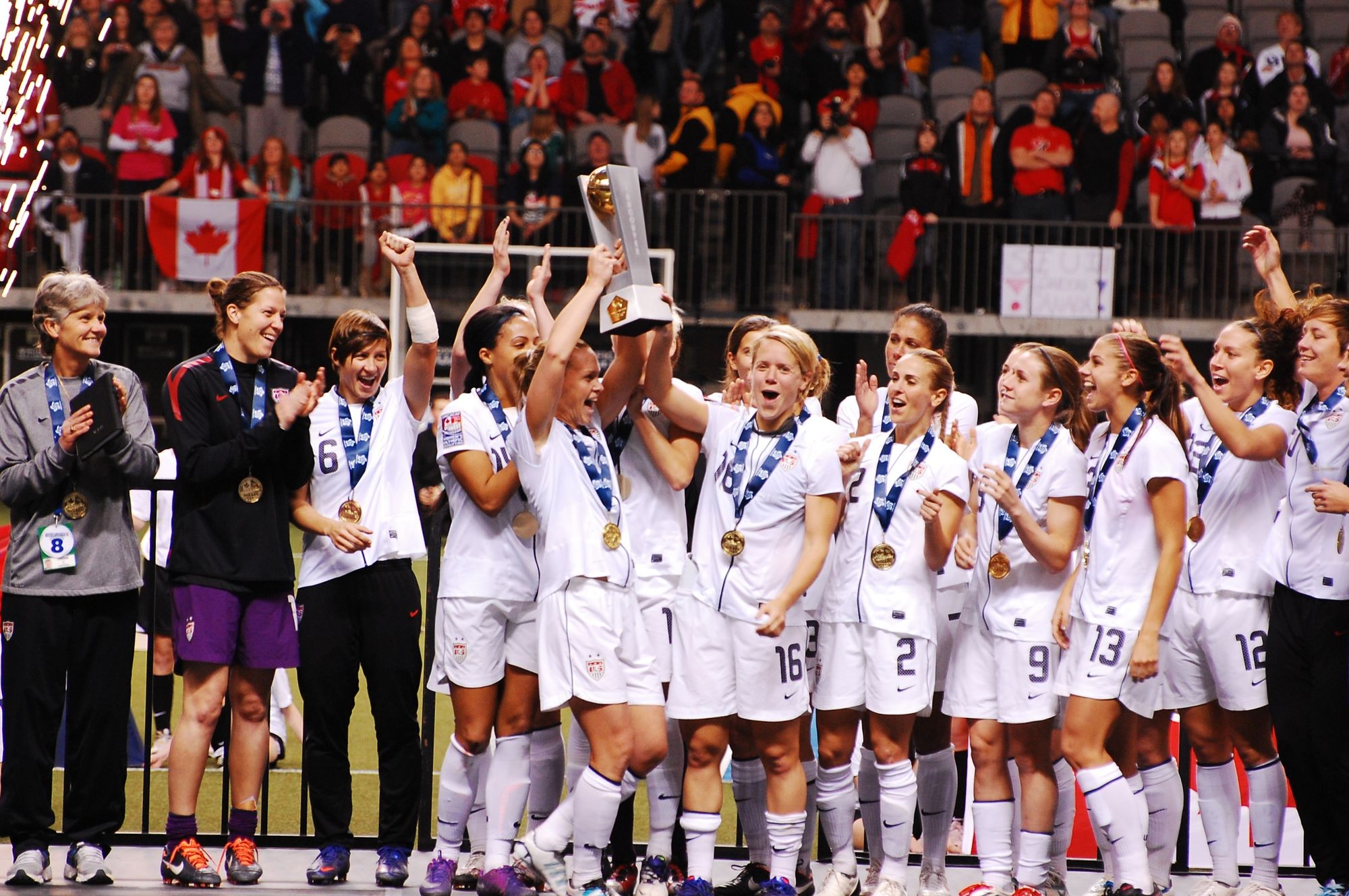Despite Lawsuit Win, Equal Pay Fight Isn’t Over
After almost three years, the U.S. Women’s National Team settled their equal pay lawsuit with the governing body of American soccer. Managing Sports Editor Liza Katz ’24 explains the lawsuit and what it will mean for women’s soccer going forward.


A world-famous team. A fifth World Cup title. A historic settlement. But, looking closer, so much work yet to be done.
After almost three years of contentious relations, the United States Women’s National Team (USWNT) settled their class-action equal pay lawsuit against the U.S. Soccer Federation (USSF) for $24 million. The lawsuit was initially filed in March 2019 by 28 national team players who accused the USSF of “institutionalized gender discrimination” on the basis that the team receives significantly lower compensation than their male counterparts. The players were seeking a payout of around $66 million, a total that took into account back-pay and damages, in addition to the promise of equal pay.
The two sides announced the settlement on Tuesday, Feb. 22, in a court filing which details exactly how the $24 million will be allocated. USWNT players will receive a lump-sum payment of $22 million, which will be distributed to players in a way proposed by them and approved by the District Court. The USSF will also pay another $2 million to be placed into a fund used by the players in post-career goals and charitable efforts related to women’s and girls’ soccer.
The settlement is contingent on a new collective bargaining agreement (CBA) being ratified by the players on the USWNT that contains equal pay going forward, at which point the money will be allocated and the litigation “fully resolved.” As part of the settlement, the USSF has also committed to providing equal pay going forward for the USWNT and USMNT “in all friendlies and tournaments, including the World Cup.”
Having this clause included was a huge win for the players, as the discrepancy in World Cup and post-game bonuses was an issue for the team in the past. Before the lawsuit, under the old CBA, making a World Cup team would net a men’s player $67,000, while a woman would make only $37,500. A win by the USMNT against a team outside the top 25 in the FIFA rankings would result in a player receiving a bonus of $9,375, while a loss would result in a payment of $5,000. For the USWNT, a similar amount ($5,250) was awarded for a win against a team ranked outside the top eight, but nothing was paid for a loss. The USMNT’s World Cup qualifying loss to Trinidad and Tobago, which shocked the world and prevented them from going to Russia in 2018, stands out as one example of this discrepancy — USMNT players actually made money for that pitiful performance, while the women would not have, since Trinidad and Tobago was ranked 99th in the world at the time. In fact, I can’t think of a USWNT loss even close to comparable to that one since I’ve been alive.
Even winning the biggest game in soccer — the World Cup Final — wasn’t enough. Winning the World Cup would net each USMNT player $407,608, while a woman would make $110,000. The men’s team has never even made a World Cup Final, let alone won one. The last time the USMNT even qualified for the tournament was in 2014, whereas the USWNT has won not one, but two, Women’s World Cup titles since then, in 2015 and 2019.
The USWNT Players Association called the settlement “an important step in righting the many wrongs of the past.” That past has included a lot of setbacks: in May 2020, the equal pay portion of the lawsuit was dismissed, forcing the players to file an appeal, which they won. In the end, USWNT players emerged with a considerable amount of money, albeit less than what they asked for initially.
I do agree with what many soccer pundits have been saying since the news broke: by settling with the team, U.S. Soccer has done little to mend their public image, which has taken a huge hit since the beginning of this saga. An example from my recent memory of USWNT matches: on March 11, 2020, the USWNT took the field for the SheBelieves Cup final against Japan. Playing on home soil, they emerged from the tunnel wearing their warm-up jerseys inside out in protest against U.S. Soccer’s most recent court filing. That court filing, sent in the day before the match by lawyers representing the USSF, argued, among other things, that the two teams “do not perform equal work requiring equal skill [and] effort,” because “the overall soccer-playing ability required to compete at the senior men’s national team level is materially influenced by the level of certain physical attributes such as speed and strength.” They also argued that this is not “a sexist stereotype,” just “indisputable science.” This antiquated argument was yet another symbol of the system that the team was trying to dismantle by filing the lawsuit in the first place.
Since the lawsuit was filed, USWNT games have been filled with signs, chants, T-shirts, you name it, promoting equal pay. I actually experienced this for myself when I went to watch the USWNT play Spain on March 9, 2020, at Red Bull Arena in Harrison, N.J. While the game ended with a 1-0 U.S. win, it almost didn’t feel like one because of the obvious tension between U.S. Soccer and their fans. It felt like fans were spending more energy jeering the USSF than cheering on the team — the chants for equal pay began almost immediately and didn’t stop until the game was over and the stadium was almost empty. Now that the long-awaited first step toward reaching that goal has been achieved, what comes next?
Women’s soccer has come a long way in the last few months. The USWNT won a bronze medal at the rescheduled 2020 Tokyo Olympics, after winning their fifth World Cup in 2019. The National Women’s Soccer League (NWSL) is getting its highest viewership in the league’s history; the league is adding two new expansion teams, San Diego Wave FC and the majority-female-owned Angel City FC; and Washington Spirit youngster, reigning NWSL Rookie of the Year and USWNT rising star Trinity Rodman just signed the largest contract in NWSL history, a four-year deal worth $1.1 million. The USWNT is still as good as ever, and a younger generation of players are showing heaps of potential, winning the 2022 SheBelieves Cup without veterans like Megan Rapinoe, Alex Morgan, and Christen Press on the roster. It seems like it has never been better to be a women’s soccer player in the United States.
But there is still so much farther to go. The USWNT settled for about one third of their initial asking price. Retired USWNT goalkeeper Hope Solo said of the settlement, “A ‘promise’ of equal pay from the Federation and backpay for a select group of players isn’t equal pay and it’s not what this fight was about.” And as much as I despise Solo for her actions off the field, she’s right. If we really want to make Equal Pay happen in American soccer, we need to consider every single female professional soccer player, not just the 30 or so who are picked to play for the USWNT. I have friends, people whom I have met over the course of my own career, who are now pros and play for NWSL teams or hope to in the future. They deserve the same amount of respect as any USWNT player and deserve the same compensation for their work as a man gets. This goes for the retired players who started this fight too, who have no way of receiving any type of compensation for their work under the settlement. It takes a village to burn down the proverbial house, and now that the house has been burned, not everyone is seeing the fruits of their labor.
While I agree with the general public that, yes, this settlement is certainly a win, we have to dig deeper. With equal pay, any progress in the right direction is progress worth celebrating. But, looking into the weeds, it is easy to see that we are viewing this settlement through rose-colored glasses. There is so much farther still to go — and we cannot stop now. If you want to get involved, there are petitions you can sign (like this one on Change.org), organizations you can volunteer with (like the Equity Project), and so many other things you can do to make your voice, and all the other voices in female athletics, heard. In no way will this fight end with the USWNT’s settlement. It is just one country, in one sport, for one team. And I, for one, will not fall silent.




Comments ()